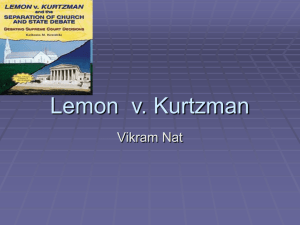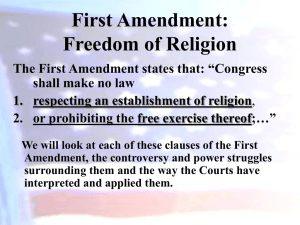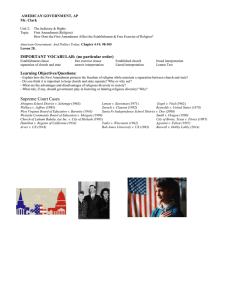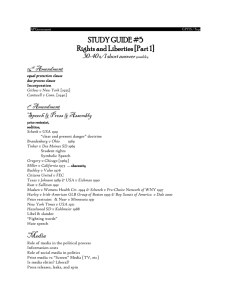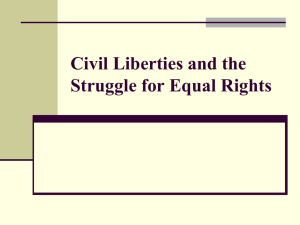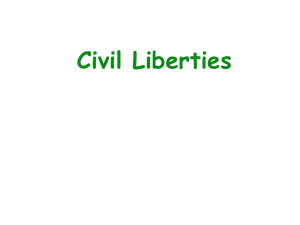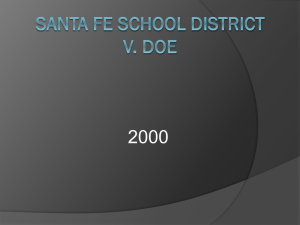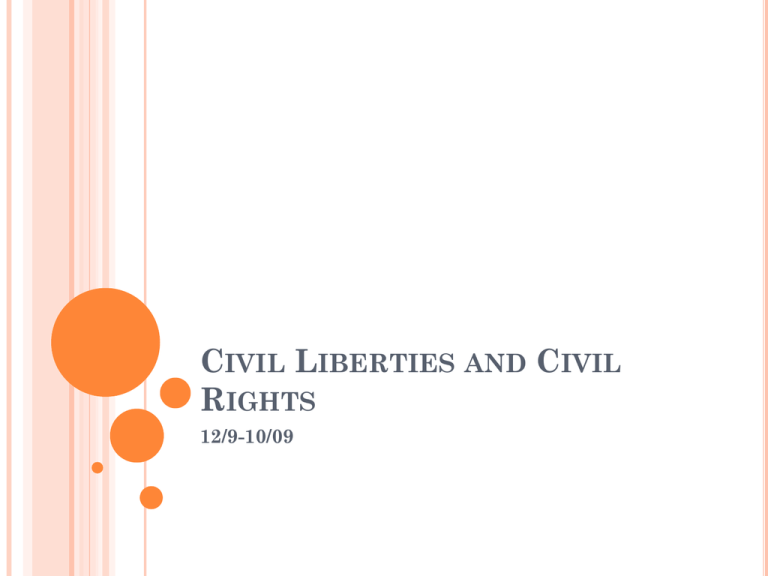
CIVIL LIBERTIES AND CIVIL
RIGHTS
12/9-10/09
RELIGION
The first amendment states,
“Congress shall make no law
respecting an establishment of
religion, or prohibiting the free
exercise thereof.”
The first part is called the
establishment clause and states that
the government can’t set up an
official religion. This is characterized
as freedom from religion.
The second part is called the free
exercise clause and states that the
people can practice whatever religion
they want. This is characterized as
freedom of religion.
TWO SCHOOLS OF THOUGHT
Separationists- believe
the establishment clause
of the 1st amendment
requires building a “wall
of separation” between
church and state.
Not used until 1802 by
Jefferson
Accomodationistsbelieve the establishment
clause of the 1st
amendment would permit
the government to
provide financial support
for certain religious
institutions and
programs or sponsor
specific religious
practices, such as prayer
in public schools.
“Believing with you that
religion is a matter which
lies solely between Man &
his God, that he owes
account to none other for
his faith or his worship,
that the legitimate powers
of government reach actions
only, & not opinions, I
contemplate with sovereign
reverence that act of the
whole American people
which declared that their
legislature should "make no
law respecting an
establishment of religion, or
prohibiting the free exercise
thereof," thus building a
wall of separation between
Church & State. “
HOW DOES THE SUPREME COURT DECIDE IF
THE GOVERNMENT IS ESTABLISHING RELIGION?
Lemon Test- established after Lemon
v. Kurtzman, a 3 part test for
establishment clause violations
Does the law or practice have a secular
(nonreligious) purpose? YES
Does the primary intent or effect of the law
either advance or inhibit religion? NO
Does the law or practice create an excessive
entanglement of government and religion?
NO
Pass!
If the answer is different than these the
measure fails the test.
Journal-Do you think that if teachers were
to lead prayers before every class period it
would pass the Lemon test?
TndHE RIGHT TO BEAR ARMS
2 Amendment “A well regulated
Militia, being necessary to the security of
a free State, the right of the people to
keep and bear Arms, shall not be
infringed”
http://www.law.umkc.edu/faculty/project
s/ftrials/conlaw/dcvheller.html
Recently, the supreme court has made it
clear that the “right of the people” is an
individual right, not a right reserved for
those in military service. 2008 (DC v.
Heller)
However Scalia also states in his
opinion, “The Constitution leaves the
District of Columbia a variety of tools for
combating that problem, including some
measures regulating handguns. “
SEARCH AND SEIZURE RIGHTS
4th amendment “the right of the people
to be secure in their persons, houses,
papers, and effects, against
unreasonable searches and seizure,
shall not be violated, and no warrants
shall issue, but upon probably clause,
supported by Oath or affirmation, and
particularly describing the place to be
searched, and the persons or things to
be seized.”
Mapp v. Ohio
Exclusionary rule- under this rule,
evidence that is obtained improperly by
the police cannot be used to prosecute
someone accused of a crime
SELF-INCRIMINATION
The fifth amendment gives people
the right to not incriminate
themselves.
Incriminating statements must be
made voluntarily, not under
coercion (threats of violence or
actual violence)
Miranda v. Arizona- supreme
court decision that requires police
officers, before questioning a
suspect in custody, to inform that
suspect about the right to remain
silent and to have an attorney
present during questioning.
RIGHT TO PRIVACY
The word privacy does not appear in the
constitution.
Nevertheless, the Supreme Court has used its
interpretive powers to recognize a right to
privacy that protects people from government
interference in a number of contexts.
In 1986 Bowers v. Hardwick, the court said the
constitution did not protect individuals of the
same gender’s sexual conduct.
This was overturned in 2003 by Lawrence v.
Texas by asserting a right to privacy.
This “right to privacy” has been the basis of the
courts decisions to strike down laws banning
birth control in Griswold v. Connecticut
(1965) and abortion in Roe v. Wade (1973)
Do you see a implied right to privacy in the
constitution?
CIVIL RIGHTS
Civil Rights are the application of
rights equally amongst all groups no
matter their race, sex, age, sexual
orientation, or disability.
People of all groups have taken
action over time to achieve equal
political, conditional, and
opportunity rights.
These goals were first realized in the
United States with the adoption of
the 14th amendment following the
Civil War.
This amendment guaranteed “that no
state shall” deprive the rights of
citizenship, equal protection of the law,
and the right to due process under the
law.
AFRICAN AMERICANS
Following the Civil War,
southern states tried to
maintain the dominance of
whites by enacting Jim
Crow laws that would
segregate (separate) blacks
and whites.
1896 Plessy v. FergusonSC ruled that as long as
facilities were equally
provided they could be
separate.
1954 Brown v. Board of
Education- SC ruled that
facilities that were
separate were inherently
unequal.
WOMEN
Women were specifically left out of
the 14th amendment much to the
dismay of some women’s right
activists who were also ardent
abolitionists.
Several states allowed women to
vote (Wyoming for instance) but
most states did not allow it.
Women around the country worked
to get referendums placed on
ballots to be voted on but with
limited success
Finally, in 1918, the US Congress
finally had enough support to pass
the 19th Amendment and
guarantee women the right to vote,
ratified in 1920.

